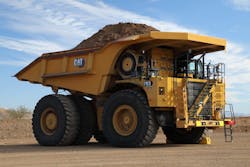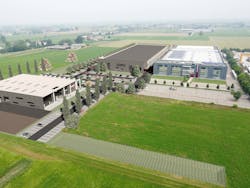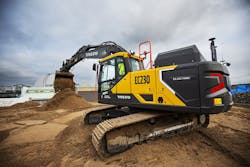This Week in Power & Motion: Caterpillar Demonstrates Battery Electric Mining Truck
There is much going on in the world of fluid power and motion control, from technology introductions and industry advancements to new trends and industry leaders. Each week the Power & Motion team collects some of the latest industry news to help keep our readers up to date on what's happening in the industries in which they work.
Walvoil Expands Production Facility, Builds New Innovation Center
Walvoil, part of the Interpump Group, is expanding one of its production facilities in the Reggio Emilia region of Italy. The company is also building a new innovation center at the site.
The expanded production facility will encompass 9,000 sq. m and the innovation center 3,000 sq. m. Walvoil intends to build both using modern methods to ensure efficiency and sustainability. The new innovation center will house the company's research and development laboratories which conduct research activities for Walvoil's branches around the world.
Production capacity will be doubled at the expanded manufacturing facility, enabling Walvoil to meet continued demand for its products. "Andrea Ferrari, Sales & Marketing Director, in the company's press release announcing the facility expansion. "In recent years we have found a strong interest in our electronic products, pumps and motors and in compact hydraulics to complete the historical product of directional valves. The expansion of production goes in the direction of satisfying this important growth."New Volvo Electric Excavator to Work on Fossil-Free Site
Volvo Construction Equipment (Volvo CE) has developed a 23-ton electric excavator, the EC230, which is currently only available in select markets. It is one of the few commercially available mid-size electric machines in the marketplace currently, and will soon be put to work in Sweden.
The EC230 Electric excavator will aid with the building of a new neighborhood in Stockholm. The job site will be a test for emissions-free construction as the project stipulates use of fossil-free contracts and a requirement that at least one of the larger excavators on the site be electric. Other machines will be run on hydrogenated vegetable oil (HVO).
In addition to the excavator, Volvo CE will provide a mobile peak-shaving power unit; this will help the electric-powered machine to excavate 75,000 tons of rock and 96,000 tons of soil in the first stages of the project, for an estimated 2,700 working hours said the company in its press release announcing the project. Besides aiding with sustainability targets, the project will enable Volvo CE to conduct further testing of its electric machine in a real-world application. Doing so ensures any future developments on the machine meet customer needs.
Ouster Merging with Velodyne
Digital lidar company Ouster plans to merge with Velodyne, a developer of real-time surround view lidar sensors. Ouster stated in a press release announcing the merger it is expected to drive significant value creation and result in a strong financial position through robust product offerings, increased operational efficiencies, and a complementary customer base in fast-growing end-markets.
Strengths Ouster said the combined company will provide include:
- Operational synergies across engineering, manufacturing, and general administration
- Robust product offerings, including verticalized software, to serve a broad set of customers
- Complementary customer base, partners, and distribution channels, coupled with reduced product costs and an innovative roadmap, to accelerate lidar adoption
- Extensive intellectual property portfolio
The newly combined company will be led by Angus Pacala, currently CEO of Ouster, and Dr. Ted Tewksbury, CEO of Velodyne. Pacala will be CEO of the new company and Tewksbury will serve as Executive Chairman of the Board.
READ MORE about Ouster's digital lidar technology.
igus Joins IoT Use Case Expert Network
To help customers more easily take advantage of digital technologies such as the Internet of Things (IoT), igus has joined the Berlin-based IoT Use Case expert network. The company said in a press release discussing its membership in the network that the uptake for digital solutions remains slow despite the efficiency gains which can be achieved.
As such, the company feels joining the network will help to accelerate uptake of digitalization. "By doing educational work with best practice examples, sharing expertise, and generating synergy effects, we hope to make it easier for companies to get into the Internet of Things and enhance their future competitiveness," said Richard Habering, head of the smart plastics business unit at igus, in the company's press release.
igus is bringing its expertise in developing smart plastics - those with sensors to monitor energy chain and cable performance - to the network. With this type of technology, better maintenance planning can be achieved. The company has shared a case study about the success one of its customers had using the smart plastics; sharing such stories is a key initiative of the network to help further demonstrate real-world use cases for IoT and other digital solutions.
Caterpillar Demonstrates Battery-Electric Mine Truck
On November 22, Caterpillar announced it successfully demonstrated its first battery electric 793 large mining truck. In conjunction, it announced plans to invest in transforming its proving grounds in Arizona into a sustainable testing and validation hub.
The prototype of the electric mine truck was developed with input from key mining customers to ensure it meets their needs. Many of these customers were on site for the demonstrate of the truck which ran on a 7 km (4.3 mi.) course. The truck was fully loaded to its rated capacity and achieved a top speed of 60 km/h (37.3 mph) said Caterpillar in a press release announcing the successful demonstration.
Caterpillar said the truck also traveled 1 km (0.62 mi.) up a 10% grade at 12 km/h (7.5 mph); as it traveled back down the grade, energy that would otherwise have been lost was captured and regenerated for the battery. Enough energy remained in the battery for the truck to complete additional cycles after the initial run through the course.
The company's Tucson Proving Ground will be transformed into the "mine site of the future" by installing renewable energy sources customers might use at their own mining operations so Caterpillar can better test and develop solutions for the market. Green hydrogen production and natural gas are among the alternative energy sources it plans to install at the site. Wind, solar and hydrogen technology will also be installed to help power the site.
With the transformation of its proving grounds and the successful testing of the electric mine truck, Caterpillar demonstrates its continued investment in alternative energy technologies. Like many heavy equipment OEMs, it is researching and developing various diesel alternatives to help customers meet their emissions reduction targets.
READ MORE: Caterpillar Unveils Battery and Electric Machine Prototypes
About the Author
Sara Jensen
Executive Editor, Power & Motion
Sara Jensen is executive editor of Power & Motion, directing expanded coverage into the modern fluid power space, as well as mechatronic and smart technologies. She has over 15 years of publishing experience. Prior to Power & Motion she spent 11 years with a trade publication for engineers of heavy-duty equipment, the last 3 of which were as the editor and brand lead. Over the course of her time in the B2B industry, Sara has gained an extensive knowledge of various heavy-duty equipment industries — including construction, agriculture, mining and on-road trucks —along with the systems and market trends which impact them such as fluid power and electronic motion control technologies.
You can follow Sara and Power & Motion via the following social media handles:
X (formerly Twitter): @TechnlgyEditor and @PowerMotionTech
LinkedIn: @SaraJensen and @Power&Motion
Facebook: @PowerMotionTech

Leaders relevant to this article:




